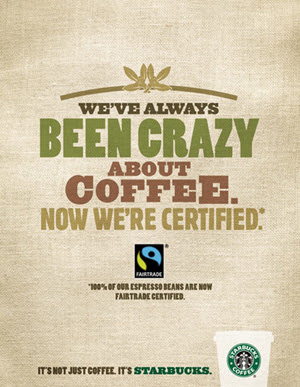Statement of Intent
How do you intend to use the four areas of the media theoretical framework to communicate meaning and meet the requirements of your chosen brief?
Firstly, I intend to create a direct link with my fashion brand and fair trade, I will do this through the mise-en-scene as the shoot will take place outdoors in a natural environment such as a field which will include natural lighting, implicating that the company is fair trade and uses natural sources. To meet the requirement regulations, the clothing worn by the model will be unbranded so that other brands are not advertised and the image remains solely on the company of fair trade fashion (Cottee). My logo will be placed in the corner but big enough to stand out as the mise-en-scene needs to be light enough so that the logo contrasts with it so it stands out more.
My target audience will be female teens/young adults (ages 14-28) in the demographic category AB who are into casual comfortable fashion. The models will not be posed provocatively as the Avertising Standards Authority forbids sexualisation of under 18s as my model will be under 18 to represent the brand and clothing as hip and youthful. My target audience sould be familiar to more costly brands such as Topshop and Zara so are more willing to spend extra on the product due to it having more expense and value due to the fair trade make and quality which benefits cotton farmers and the environment.
The fair trade element should be presented prominently within the product as well as portraying the audience needs shown through the clothing types.
The logo will also help to reinforce the fair trade cotton that the clothes are made from; this is because the logo 'Cottee' will hopefully be recognised due to the name being a mix of 'cotton' and 'tee' (as in shirt) which relates to the materials used within the clothing. The logo reinforces this even further through the image of a cotton bud conjoining the t's together, signifying the universality of the product, joined together with fair trade for quality, natural, thoughtfully made clothing.
The media industries will influence how the company gets from people to people which can be done through billboard advertisements, leaflets, posters etc. These posters shall be placed in areas where there will be a lot of public sighting, so would therefore benefit being debuted in towns and cities where many people are subjected to advertisement influence therefore intrigue customers who are interested and persuade others to buy with subliminal messaging. The cotton is produced by farmers and workers in places such as India, Peru, Mali and Brazil then is collected and sent to factories where there is equal pay and exceptional working conditions so that workers earn a better income to spend on creating better and healthier living conditions for those in that area.
Firstly, I intend to create a direct link with my fashion brand and fair trade, I will do this through the mise-en-scene as the shoot will take place outdoors in a natural environment such as a field which will include natural lighting, implicating that the company is fair trade and uses natural sources. To meet the requirement regulations, the clothing worn by the model will be unbranded so that other brands are not advertised and the image remains solely on the company of fair trade fashion (Cottee). My logo will be placed in the corner but big enough to stand out as the mise-en-scene needs to be light enough so that the logo contrasts with it so it stands out more.
My target audience will be female teens/young adults (ages 14-28) in the demographic category AB who are into casual comfortable fashion. The models will not be posed provocatively as the Avertising Standards Authority forbids sexualisation of under 18s as my model will be under 18 to represent the brand and clothing as hip and youthful. My target audience sould be familiar to more costly brands such as Topshop and Zara so are more willing to spend extra on the product due to it having more expense and value due to the fair trade make and quality which benefits cotton farmers and the environment.
The fair trade element should be presented prominently within the product as well as portraying the audience needs shown through the clothing types.
The logo will also help to reinforce the fair trade cotton that the clothes are made from; this is because the logo 'Cottee' will hopefully be recognised due to the name being a mix of 'cotton' and 'tee' (as in shirt) which relates to the materials used within the clothing. The logo reinforces this even further through the image of a cotton bud conjoining the t's together, signifying the universality of the product, joined together with fair trade for quality, natural, thoughtfully made clothing.
The media industries will influence how the company gets from people to people which can be done through billboard advertisements, leaflets, posters etc. These posters shall be placed in areas where there will be a lot of public sighting, so would therefore benefit being debuted in towns and cities where many people are subjected to advertisement influence therefore intrigue customers who are interested and persuade others to buy with subliminal messaging. The cotton is produced by farmers and workers in places such as India, Peru, Mali and Brazil then is collected and sent to factories where there is equal pay and exceptional working conditions so that workers earn a better income to spend on creating better and healthier living conditions for those in that area.


































